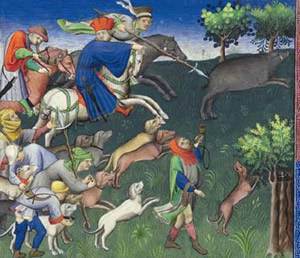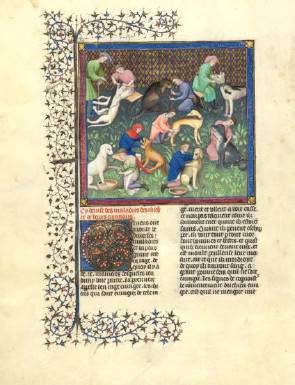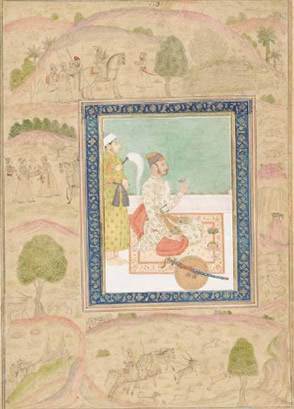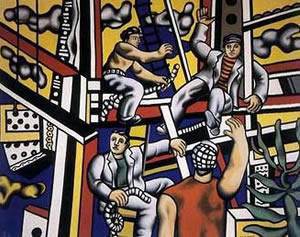
Hunting Party Pursuing Wild Boar, Gaston Phoebus, “Le Livre de la chasse,”
France, Paris, ca. 1407. Bequest of Clara S. Peck, 1983. MS M.1044 (fol. 64).

Care of Sick and Injured Dogs
Gaston Phoebus (1331–1391), Le Livre de la chasse, in French
France, Paris, ca. 1407
The Morgan Library & Museum; MS M.1044 (fol. 31v)
Bequest of Clara S. Peck, 1983
Image courtesy of Faksimile Verlag Luzern, www.faksimile.ch

Seated Nobleman Holding a Pink Flower with Hunting Scenes in Borders
Leaf from the Read Albums
India, Deccan, during the years of Mughal rule (1687–1724).
The Morgan Library & Museum; MS M. 458.4 (fol. 4)
Purchased by Pierpont Morgan, 1911
Photography by Joseph Zehavi, 2008.
EXTRAORDINARY 15th CENTURY MANUSCRIPT IS THE CENTERPIECE OF A NEW EXHIBITION AT THE MORGAN LIBRARY & MUSEUM
Illuminating the Medieval Hunt – April 18 through August 10, 2008
]]>
A new exhibition featuring nearly fifty miniatures from the Morgan’s celebrated hunting manuscript by Gaston Phoebus (1331–1391), Le Livre de la chasse (Paris, ca. 1407), is on view at The Morgan Library & Museum from April 18 through August 10, 2008. Illuminating the Medieval Hunt presents a unique opportunity for the public to see a large number of these miniatures displayed together because this manuscript has been disbound temporarily for conservation and the preparation of a facsimile. Visitors can leaf through a copy of the facsimile and compare these images with those in other original manuscripts and early printed editions that demonstrate how hunting themes made their way into a broader cultural context in religious literature as well as secular texts. About two dozen manuscripts and printed books, dating from the eleventh to the sixteenth century, are on display.
Considered the sport of kings and noblemen, hunting was a popular aristocratic pastime during the medieval period. Numerous manuscripts were written on the subject, and these treatises, made for wealthy patrons, were often lavishly decorated. Among the most famous and earliest medieval texts on hunting, Le Livre de la chasse was written by Phoebus between 1387 and 1389 and dedicated to Philip the Bold (1342–1404), Duke of Burgundy. Although the dedication manuscript is lost, numerous copies were customarily commissioned by noblemen.
The Morgan’s Le Livre de la chasse is thought to have been commissioned by Philip the Bold’s son, John the Fearless (1371–1419), who presumably inherited his father’s manuscript and had copies made. During the late fifteenth century, it was owned by King Ferdinand II of Aragón and Queen Isabella of Castile, who added to it their full-page coat of arms. Of the forty-six known surviving copies of the manuscript, the Morgan’s is one of the two finest extant examples; the other, in the Bibliothèque nationale de France, was made at the same time and contains the same cycle of eighty-seven miniatures.
Le Livre de la chasse is divided into four books: on gentle and wild beasts; on the nature of dogs and their care; on hunting in general and hunting with dogs; and on hunting with traps, snares, and cross bow. Written in French, the work was enormously popular throughout Europe and England, where it was translated under the title, Master of Game.
The miniatures of the Morgan manuscript are shown in their proper sequence, revealing the characteristics and habits of the animals, the various devices and strategies involved in the hunt, and the costumes of both the aristocratic hunters and their servants. A large number of miniatures are devoted to the hound, which Phoebus called the “noblest and most reasonable beast that God ever created.” Phoebus bred hunting dogs and, according to the famous chronicler Jean Froissart, kept kennels for some 1,600 hounds.
“Illuminated manuscripts are a cornerstone of the Morgan’s permanent collections and this manuscript ranks high among its greatest treasures,” said William M. Griswold, director of the Morgan Library & Museum. “The hunting scenes are extraordinary, both for the vitality of the action represented and their artistry. We are particularly pleased to be able to share with the public for the first and only time so many of the miniatures from this magnificent volume.”
The exhibition includes extremely rare first and second printed editions of Le Livre de la chasse (both issued in Paris around 1507) along with the first printed book on hunting (Chambéry, 1486), also based on a fourteenth-century text. Also on view are the first and second editions of the “Book of St. Albans,” the first English book on hunting, with additional sections on heraldry and falconry. The printed editions tapped a newly emerging middle class market with cheaper versions of a text originally intended for an aristocratic audience. Nonetheless, the noble origins of the sport are apparent in editions of George Gascoigne’s The Noble Art of Venerie or Hunting (London, 1575 and 1611), which contain portraits of Queen Elizabeth I and King James I in their capacity as heads of state and leaders of the chase.
The medieval hunt was often used as a metaphor in both profane and sacred texts. In a sixteenth-century Flemish miniature, the object of the falconer’s hunt is the young lady peering out of a window. In another Flemish miniature of about 1500, depicts the hunt of the unicorn annunciation. The archangel Gabriel’s hunting dogs chase the unicorn into the lap of the Virgin Mary.
The exhibition concludes with a few examples of Islamic and Indian paintings, demonstrating that the noble hunt was not limited to Europe. In an Indian manuscript of Nizami’s Khamsa of ca. 1618, King Bahrum Gur fells an onager with an arrow that pins its hoof to its ear, and a seventeenth-century album leaf shows a seated nobleman framed by various hunting scenes.
Follow us on:


